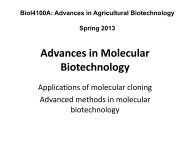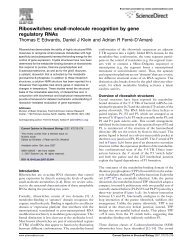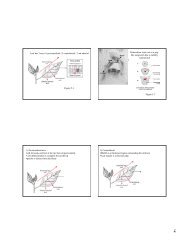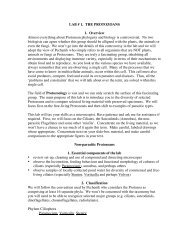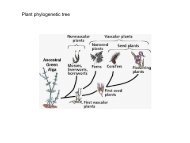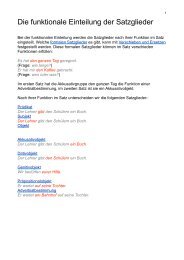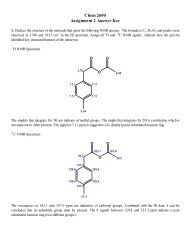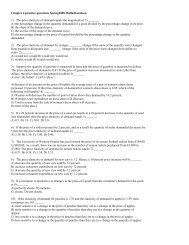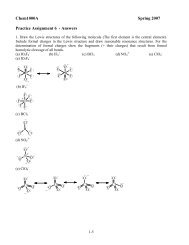Lecture 16-Rotifers.pdf - Classes at U. of L.
Lecture 16-Rotifers.pdf - Classes at U. of L.
Lecture 16-Rotifers.pdf - Classes at U. of L.
Create successful ePaper yourself
Turn your PDF publications into a flip-book with our unique Google optimized e-Paper software.
Phylum Rotifera—”wheel bearers”<br />
•Microscopic(2000 spp.<br />
•Bil<strong>at</strong>eral symmetrical pseudocoelom<strong>at</strong>es<br />
•Body somewh<strong>at</strong> cylilndrical with an anterior cili<strong>at</strong>ed disc (corona) and a posterior<br />
forked tail (foot)<br />
•Body covered with a cuticle th<strong>at</strong> is sometimes modified into a hardened shell-like<br />
cover (lorica)<br />
•Digestive tract usually complete with a mouth, pharynx, stomach, intestine and<br />
an anus.<br />
•Pharynx equipped with movable jaws (mastax, trophi) usually for grinding up<br />
algae<br />
•No obvious eyes or other sense organs.<br />
•Parthenogenesis common, males unknown in many species, about 1500 species<br />
•Mostly freshw<strong>at</strong>er species—believed to have origin<strong>at</strong>ed in FW—common in the<br />
plankton <strong>of</strong> lakes, and living on plants and <strong>at</strong>tached algae as well in both lakes<br />
and streams.<br />
•Exhibit eutely—body has a constant number (about 1000) <strong>of</strong> cells, th<strong>at</strong> grow in<br />
size as the animal grows larger.
An<strong>at</strong>omy <strong>of</strong> Euchlanis—a planktonic rotifer<br />
Corona<br />
Nephridia—flame cells<br />
Gastric glands<br />
foot<br />
mastax<br />
Trophi (2)<br />
toe<br />
Urinary bladder<br />
oviduct<br />
intestine<br />
Vitelline gland<br />
stomach
Close-up <strong>of</strong> the jaws-trophi <strong>of</strong> a rotifer<br />
Key:<br />
F fulcrum; M<br />
manubrium; R<br />
ramus; U uncus.<br />
Once food is captured by the corona it passes into a mouth and a muscular pharynx called the<br />
mastax, which is equipped with a set <strong>of</strong> grinding jaws called the trophi. The ground up food is<br />
then passed on to the esophagus and stomach.
Class Bdelloidea—means “leech like”<br />
Body large (> 0.3 mm) elong<strong>at</strong>e, s<strong>of</strong>t bodied forms,<br />
creeping worm-like movement, with no lorica, head<br />
and food flexible and retractile, creeping forms<br />
benthic or epiphytic, foot with two toes, paired<br />
ovaries, corona with two circular lobes<br />
Sex is unknown in bdelloids, only parthenogenetic<br />
females exist, > 300 known species<br />
They are one <strong>of</strong> the most ancient asexual lineages<br />
(<strong>at</strong> least 40 million years)<br />
Many are capable <strong>of</strong> cryptobiosis<br />
Corona, two<br />
circular lobes<br />
paired ovaries<br />
Philodina—mid-section distinct from tail section<br />
Philodina
Closeup <strong>of</strong> the ram<strong>at</strong>e mastax <strong>of</strong><br />
Philodina<br />
trophi <strong>of</strong> mastax<br />
Ram<strong>at</strong>e mastax—semicircular rami with large grinding teeth<br />
http://bios.sakura.ne.jp/gf/2004/ro<br />
http://www.environmentalleverage.com/bug%20<strong>of</strong>%20the%20month/rotifer%20for%20web/rotifer2.jpg
Single ovary with one egg<br />
A rotifer carrying a single<br />
egg <strong>at</strong>tached to its body<br />
Lorica—shield-like ‘shell’<br />
sometimes with spines<br />
Class Monogononta—”single ovary”<br />
•Benthic, free swimming, or sessile forms,<br />
•lorica present or absent,<br />
•foot present or absent-toes variable,<br />
•corona usually a single cili<strong>at</strong>ed disk ringing the anterior end,<br />
•mastax not ram<strong>at</strong>e<br />
‣<strong>16</strong>00 species, mostly dioecious altern<strong>at</strong>ing between parthenogenesis and sex<br />
‣Males are usually small, with a vestigial gut, and only for sex
The Monogonont life cycle<br />
Usually while food and survival conditions<br />
are quite good most <strong>of</strong> the popul<strong>at</strong>ion are<br />
females which produce diploid eggs th<strong>at</strong><br />
h<strong>at</strong>ch to make identical copies <strong>of</strong> the<br />
female parent.<br />
During autumn the stimulus to undergo<br />
meiosis, and make haploid (mictic) eggs<br />
occurs, then if those eggs don’t get<br />
fertilized they h<strong>at</strong>ch out as males.<br />
Males will then seek out mictic females<br />
and have sex with them. The eggs<br />
produced are larger and contain more<br />
nutritional reserves than normal<br />
parthenogenetic eggs, and delay<br />
h<strong>at</strong>ching <strong>of</strong>ten till the following spring or<br />
when suitable conditions occur.<br />
Some females can do both-Amphoteric<br />
Pseudosexual eggs—parthenogenetic<br />
eggs th<strong>at</strong> look like resting eggs have been<br />
noted in some species.
Critical food popul<strong>at</strong>ions for popul<strong>at</strong>ion growth <strong>of</strong> different rotifers.<br />
Kc=Ker<strong>at</strong>ella cochlearis, Ke=K. earlinae, Kcr=K.crassa, So=Synchaeta oblong<strong>at</strong>a<br />
Sp=Synchaeta pectin<strong>at</strong>a,Bc=Brachionus calyciflorus, Pr=Polyarthra rem<strong>at</strong>a,<br />
Ap=Asplanchna priodonta. (From Stemberger and Gilbert 1985)
Lorica with anterior and posterior projecting spines, foot present--Brachionus
Lorica divided into plaques, 6 anterior spines and 1 or 2 posterior spines, foot<br />
absent--Ker<strong>at</strong>ella<br />
The length <strong>of</strong> rotifer spines increase during the summer months (cyclomorphosis), and<br />
they are generally though <strong>of</strong> as anti-pred<strong>at</strong>or devices and projections th<strong>at</strong> slow sinking
lorica with 3 very long anterior projecting spines and one long<br />
posteriorly projecting spine-- Kellicottia<br />
Female Kellicotia releasing an egg<br />
The length <strong>of</strong> rotifer spines increase during the summer months (cyclomorphosis), and<br />
they are generally though <strong>of</strong> as anti-pred<strong>at</strong>or devices and projections th<strong>at</strong> reduce<br />
sinking r<strong>at</strong>e.
om Stemberger 1988
Wh<strong>at</strong> conditions are good for rotifers?
1 mm<br />
Asplanchna—large pred<strong>at</strong>ory species<br />
(> 1mm) sac-like body shape,quite<br />
transparent,<br />
Corona a single circumapical ring <strong>of</strong><br />
cilia, no lorica, foot present or absent,<br />
but never distinct foot with separ<strong>at</strong>ed<br />
toes, intestine and anus lacking
The incud<strong>at</strong>e trophi <strong>of</strong> Asplanchna priodonta—rami shaped as jaw-like pincers<br />
http://users.unimi.it/melone/trophi/start.html
Family Synchaetidae—Synchaeta, most marine/estuarine species in this family<br />
no lorica, foot present, anterior region wide, with 4 stiff anterior styles—




